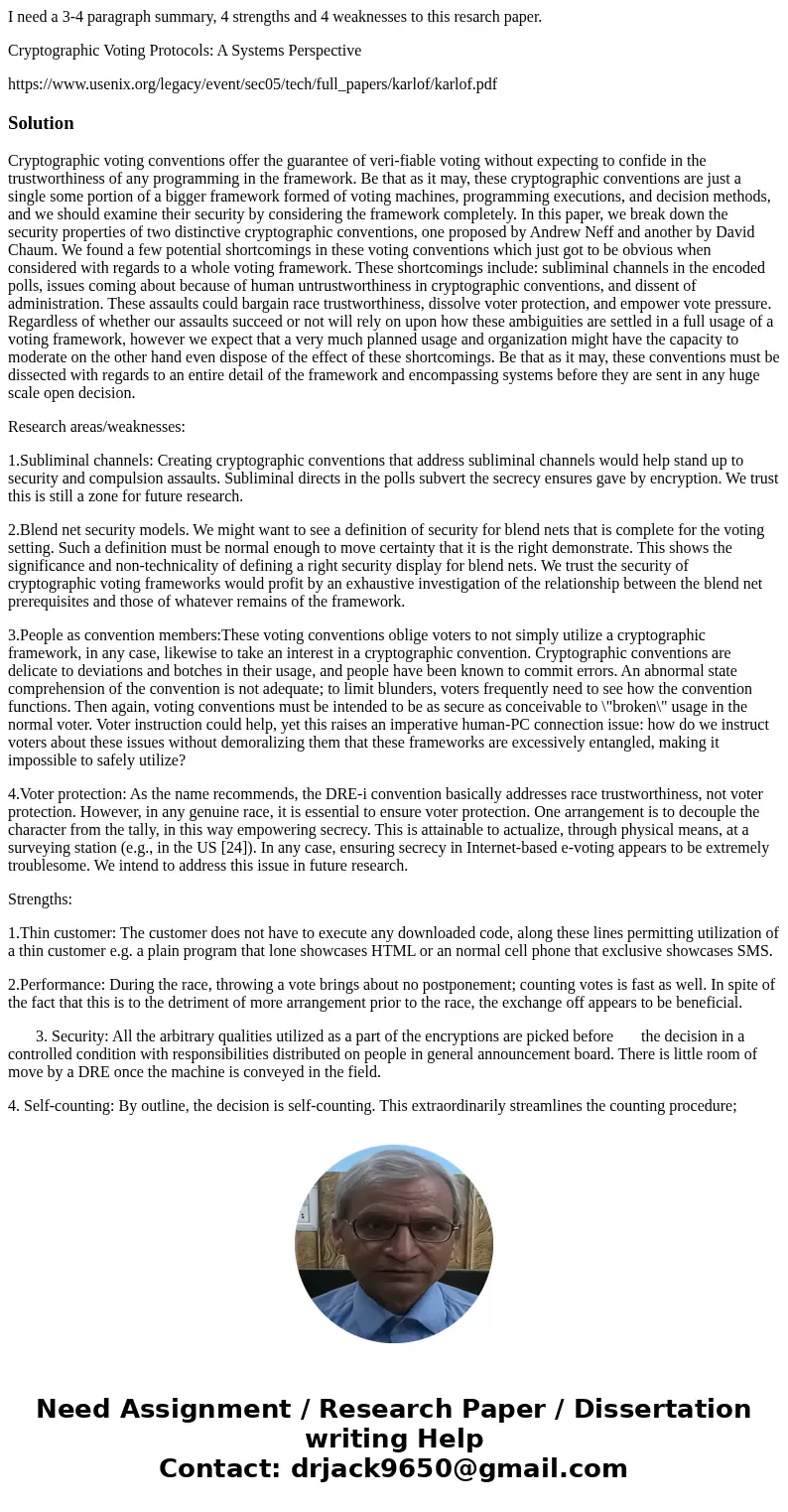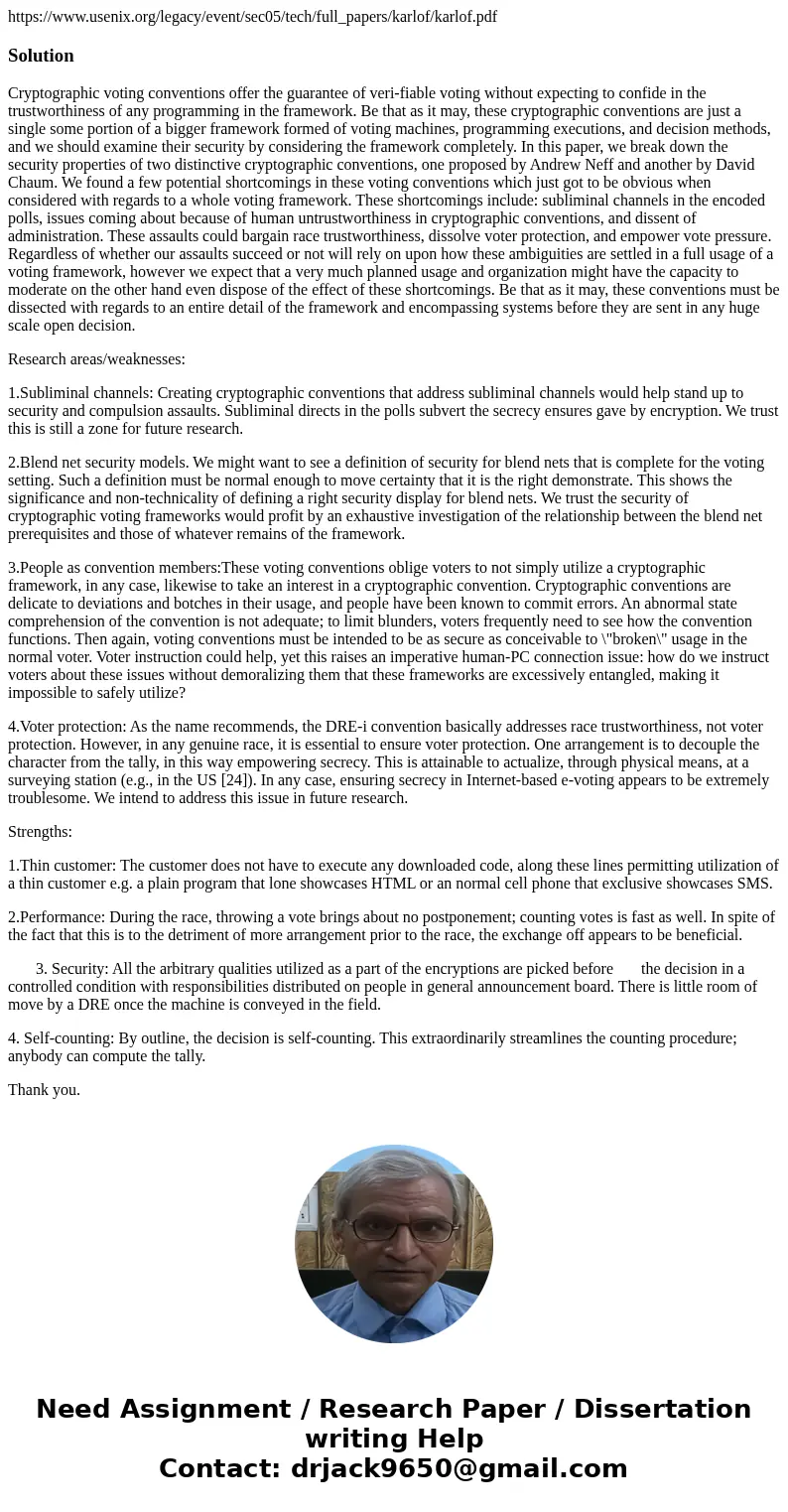I need a 34 paragraph summary 4 strengths and 4 weaknesses t
I need a 3-4 paragraph summary, 4 strengths and 4 weaknesses to this resarch paper.
Cryptographic Voting Protocols: A Systems Perspective
https://www.usenix.org/legacy/event/sec05/tech/full_papers/karlof/karlof.pdf
Solution
Cryptographic voting conventions offer the guarantee of veri-fiable voting without expecting to confide in the trustworthiness of any programming in the framework. Be that as it may, these cryptographic conventions are just a single some portion of a bigger framework formed of voting machines, programming executions, and decision methods, and we should examine their security by considering the framework completely. In this paper, we break down the security properties of two distinctive cryptographic conventions, one proposed by Andrew Neff and another by David Chaum. We found a few potential shortcomings in these voting conventions which just got to be obvious when considered with regards to a whole voting framework. These shortcomings include: subliminal channels in the encoded polls, issues coming about because of human untrustworthiness in cryptographic conventions, and dissent of administration. These assaults could bargain race trustworthiness, dissolve voter protection, and empower vote pressure. Regardless of whether our assaults succeed or not will rely on upon how these ambiguities are settled in a full usage of a voting framework, however we expect that a very much planned usage and organization might have the capacity to moderate on the other hand even dispose of the effect of these shortcomings. Be that as it may, these conventions must be dissected with regards to an entire detail of the framework and encompassing systems before they are sent in any huge scale open decision.
Research areas/weaknesses:
1.Subliminal channels: Creating cryptographic conventions that address subliminal channels would help stand up to security and compulsion assaults. Subliminal directs in the polls subvert the secrecy ensures gave by encryption. We trust this is still a zone for future research.
2.Blend net security models. We might want to see a definition of security for blend nets that is complete for the voting setting. Such a definition must be normal enough to move certainty that it is the right demonstrate. This shows the significance and non-technicality of defining a right security display for blend nets. We trust the security of cryptographic voting frameworks would profit by an exhaustive investigation of the relationship between the blend net prerequisites and those of whatever remains of the framework.
3.People as convention members:These voting conventions oblige voters to not simply utilize a cryptographic framework, in any case, likewise to take an interest in a cryptographic convention. Cryptographic conventions are delicate to deviations and botches in their usage, and people have been known to commit errors. An abnormal state comprehension of the convention is not adequate; to limit blunders, voters frequently need to see how the convention functions. Then again, voting conventions must be intended to be as secure as conceivable to \"broken\" usage in the normal voter. Voter instruction could help, yet this raises an imperative human-PC connection issue: how do we instruct voters about these issues without demoralizing them that these frameworks are excessively entangled, making it impossible to safely utilize?
4.Voter protection: As the name recommends, the DRE-i convention basically addresses race trustworthiness, not voter protection. However, in any genuine race, it is essential to ensure voter protection. One arrangement is to decouple the character from the tally, in this way empowering secrecy. This is attainable to actualize, through physical means, at a surveying station (e.g., in the US [24]). In any case, ensuring secrecy in Internet-based e-voting appears to be extremely troublesome. We intend to address this issue in future research.
Strengths:
1.Thin customer: The customer does not have to execute any downloaded code, along these lines permitting utilization of a thin customer e.g. a plain program that lone showcases HTML or an normal cell phone that exclusive showcases SMS.
2.Performance: During the race, throwing a vote brings about no postponement; counting votes is fast as well. In spite of the fact that this is to the detriment of more arrangement prior to the race, the exchange off appears to be beneficial.
3. Security: All the arbitrary qualities utilized as a part of the encryptions are picked before the decision in a controlled condition with responsibilities distributed on people in general announcement board. There is little room of move by a DRE once the machine is conveyed in the field.
4. Self-counting: By outline, the decision is self-counting. This extraordinarily streamlines the counting procedure; anybody can compute the tally.
Thank you.


 Homework Sourse
Homework Sourse